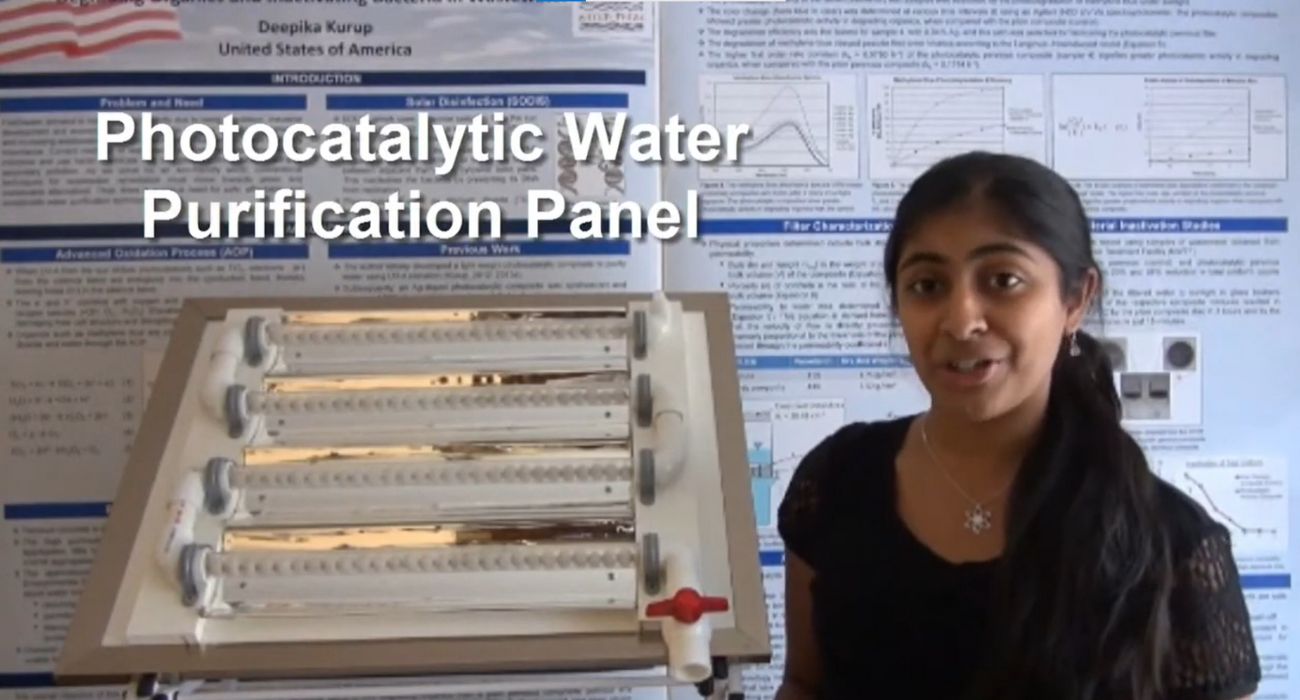14-Year-Old Deepika Kurup Invents a Solar-Powered Water Purification System

Imagine waking up every morning and walking miles just to collect water that could make you sick. Now imagine being 14 years old and deciding that wasn’t acceptable—not just for you, but for millions of people around the world.
Every 90 seconds, a child dies from a water-related disease. It’s a grim statistic, but for Deepika Kurup, it wasn’t just a number—it was a spark. During a visit to India, she saw children drinking from contaminated puddles, and something shifted. While most of us might’ve felt sadness or momentary guilt, she chose a different response: invention. At an age when many are just figuring out high school schedules, Deepika was figuring out how to use sunlight, science, and compassion to clean dirty water.
When Inspiration Meets Injustice: A Teen’s Wake-Up Call

For many young teens, traveling abroad is a chance to unwind, to enjoy new places and cultures, maybe even a temporary escape from school routines. But for Deepika Kurup, a visit to India became something else entirely—it was a confrontation. Outside her grandparents’ home, she watched as children collected filthy water from the street to drink, bathe, and survive. The scene was raw, unfiltered, and permanent. These children weren’t acting out of carelessness. They were simply surviving in the only way they knew how. That moment sank deep into her mind and didn’t leave. It was more than discomfort. It was outrage. For someone raised in a country where clean water flowed freely from kitchen taps, seeing kids her own age forced to drink water that could poison them felt like a slap to the conscience.
Back home in the U.S., most kids would’ve resumed their lives. School, homework, friends—everything pulling attention in different directions. But Deepika couldn’t let go. The faces she saw in India came back to her each time she turned on a faucet or opened a water bottle. What started as a haunting memory began turning into focused research.

She dove into articles and reports about waterborne illnesses, learning how over 2 billion people across the globe lacked access to safe drinking water. She found that diarrhea alone killed more children each year than AIDS, malaria, and measles combined. It wasn’t just about poverty—it was about a global system that allowed something as basic as clean water to remain out of reach for so many. And that injustice made her restless.
The turning point wasn’t a dramatic moment—it was a quiet decision. A realization that maybe she didn’t need to wait for someone else to fix it. She began looking not for sympathy, but for solutions. What could she do, as a teenager with limited resources, to prevent children from drinking water that could kill them? The answer wasn’t clear yet, but the intention was. Deepika didn’t see her age as a barrier. If anything, it gave her clarity. She wasn’t jaded by excuses or bureaucracy. She just saw a need, and she believed it could be met. That belief—unfiltered and determined—would become the foundation for everything she built next.
Building a Clean Water Solution from Scratch

Back in her home in Nashua, New Hampshire, Deepika turned frustration into focus. While most kids her age were filling notebooks with math problems and essay drafts, she was filling hers with chemical reactions, solar energy data, and purification techniques. Her bedroom started to look more like a research lab. She bought basic materials with her allowance money, reused plastic bottles, and even experimented with different minerals. Her early attempts were messy and often failed, but she saw those failures as part of the process. She wasn’t trying to impress anyone—she was trying to create something that worked in real conditions. For her, that meant a solution that didn’t require electricity, was low-cost, easy to maintain, and—above all—effective.
She started piecing together what would become the foundation of her system. She focused on titanium dioxide and zinc oxide, two materials known for their photocatalytic properties. When exposed to sunlight, they generate compounds that can kill bacteria and break down harmful pollutants in water. The science wasn’t new, but Deepika’s approach was.
She wasn’t using high-end equipment or state-of-the-art labs. She was reimagining the process through the lens of someone who had seen water scarcity up close. Her invention had to be replicable in rural villages, not just science competitions. It had to work for someone with no money, no power lines, no backup generator—just the sun overhead and the will to live.
What she eventually created was more than a prototype—it was a statement. A simple system that used solar energy and widely available materials to purify water in just a few hours. No complicated machinery. No ongoing costs. No expert needed to operate it. And despite all the challenges, she had results. Water samples that once teemed with E. coli and other bacteria tested clean after running through her device. She had transformed her moral discomfort into a working model that could save lives. And the most remarkable part? She was still just a high school student, quietly building her invention with the kind of drive that didn’t need applause to keep going.
Harnessing Sunlight to Save Lives

At the heart of Deepika’s invention is a scientific process that balances simplicity with effectiveness: solar photocatalysis. Her system relies on the natural energy of the sun to activate a reaction in titanium dioxide and zinc oxide—two minerals that, when exposed to UV light, become powerful disinfectants. These materials produce reactive oxygen species that can destroy bacteria, viruses, and organic pollutants in water. The process is efficient, repeatable, and doesn’t require electricity or additional chemicals. What’s more, these minerals are inexpensive and non-toxic, making them ideal for communities with limited access to technology or infrastructure.
But Deepika’s brilliance wasn’t just in understanding the science—it was in how she applied it. She knew that if her system was going to help real people, it needed to be durable, low-cost, and easy to use. She designed the purifier using everyday materials: plastic containers, sunlight, and her mineral solution. Once the contaminated water passed through her setup and sat in the sun, the photocatalytic reaction would begin. After a few hours, the water would be safe to drink—meeting, in some tests, the EPA’s standards for potable water. It wasn’t just an academic experiment. It was a working model for communities in need.
What makes this system so powerful is that it doesn’t rely on constant maintenance or a supply chain of filters and chemicals. Once built, it can keep working again and again with minimal input. This gives it a scalability that few other systems offer, especially in the developing world. Deepika’s invention is the kind of solution that development agencies and non-profits often spend years trying to engineer—something that works, lasts, and doesn’t cost a fortune. She didn’t wait for approval or resources. She simply asked the right question—how can I make this better?—and kept answering it until the science matched her vision.
How a Teen Inventor Captured the World’s Attention

In 2012, Deepika entered her project into the Discovery Education 3M Young Scientist Challenge—a competition designed to highlight the brightest young innovators in the country. Her entry was more than just technically sound; it was emotionally resonant. She didn’t present her water purification system as a clever experiment. She told a story—of the children in India, of her desire to help, of the nights spent mixing chemicals and testing results. The judges weren’t just moved by her science—they were moved by her purpose. She won the grand prize, earning $25,000 and a mentorship with a 3M scientist who helped her further refine her system and prepare it for larger impact.
The media spotlight followed quickly. News outlets ran stories about the “14-year-old clean water inventor.” But Deepika didn’t lean into the fame. She used it to bring the issue of water scarcity into public conversation. In interviews, she repeated a simple message: kids like her shouldn’t be the exception—they should be the norm. She emphasized that the water crisis was not just a problem for other countries. It was a global issue that demanded real, science-based solutions. And more than anything, she made people believe that change was possible—and that it didn’t have to come from the top.
What stood out most about Deepika during this time was her refusal to treat success as an endpoint. The award wasn’t the finish line—it was the starting point. She continued researching, presenting her findings, and raising awareness. She didn’t want her invention to be just another science fair headline. She wanted it to be implemented. Her persistence, her refusal to rest on early praise, is what separates her from most young achievers. She wasn’t just interested in being right—she was interested in being useful. And her focus stayed where it began: on the children whose need for clean water first lit the fire in her heart.
From Invention to Intention

Deepika’s story forces us to confront our own sense of responsibility. She didn’t have a degree, a lab team, or institutional support when she started—just a question and the courage to pursue the answer. That kind of clarity often fades with age, buried under layers of doubt, distraction, and routine. But her example reminds us that some of the most powerful ideas come from those willing to act when others look away. It challenges us to examine how we respond to the suffering we witness—do we scroll past, or do we pause long enough to do something about it?
What makes her journey resonate is that it’s not out of reach. You don’t have to be a scientist to build solutions. You just have to be someone who notices and cares. The tools you have right now—your attention, your creativity, your willingness to ask a better question—those are enough to begin. Deepika used sunlight, minerals, and patience to transform despair into progress. The magic wasn’t in the materials. It was in her decision to act with purpose. That’s what we’re being invited into—not her process, but her mindset.
As readers, the takeaway isn’t just inspiration. It’s accountability. What are we tolerating that we shouldn’t? What suffering have we normalized because we’ve seen it too often? Deepika didn’t accept the world as it was handed to her. She challenged it, improved it, and showed that one voice—backed by action—can ripple out and reach thousands. Maybe you won’t invent a device. But you might start a conversation. You might support someone else’s idea. You might simply stop turning away. And sometimes, that’s how change begins.
Featured Image Source: Deepika Kurup on YouTube
Loading...






